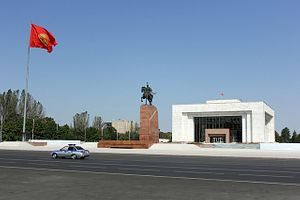Article 299-2 of Kyrgyzstan’s criminal code is the most common charge against terrorism and extremism suspects in the country. The article, which criminalizes possession of extremist material, has been used to convict at least 258 people since 2010. The definition of “extremist material” is vague, however, Human Rights Watch says in a new report, leaving the law open to easy abuse.
As Letta Tayler, the senior researcher behind the report, said in an interview, “I could be convicted under this law for keeping copies of the material I examined as part of my research.” The same goes for this article.
Originally, Kyrgyz law criminalized “the acquisition, storage [possession], transportation and transfer of extremist materials for the purpose of distribution, or their production and distribution, as well as the deliberate use of symbols or attributes of extremist organization” (emphasis added). In 2013, however, the law was amended to remove the requirement that an individual needed to show intent to distribute — making it criminal to merely posses “extremist material.” Furthermore, in 2016 mandatory prison sentences were introduced for convictions under article 299-2.
Reforms scheduled to go into effect in January 2019 are supposed to revert the law back to requiring an intent to disseminate.
What is “extremist material”? According to Human Rights Watch, the Kyrgyz definition of extremism — rooted in the 2005 Law on Countering Extremist Activity — is overly broad. The 2005 law lists not only serious crimes, like planning or committing acts of terrorism, but also “affronts to national dignity,” “hooliganism,” and “vandalism.” The 2005 law also criminalizes not just financing and facilitating such activities but also “justification of, or public calls to support.” Extremist materials are any documents or information that “call for or justify extremist views.”
According to Human Rights Watch, although the government is required to maintain a list of banned content, “for years the Ministry of Justice website created for this purpose did not include much of the material used to convict suspects under article 299-2 and, according to human rights defenders, remains incomplete.”
Kyrgyz authorities have banned 21 organizations as terrorist or extremist, including the Taliban and the Islamic State, as well as Hizb ut-Tahrir (HT) and others. The Ministry of Justice website lists 22 court decisions banning various material from the expected — websites for HT and other groups proscribed by the state — to materials many would not consider “extreme,” like a 2012 film called I am Gay and Muslim; a 2017 article published by Fergana News about social media, intolerance, and inter-ethnic tensions in Kyrgyzstan; and a 2012 report by Freedom House, the Norwegian Helsinki Committee, and the Memorial Human Rights Center chronicling the 2010 interethnic violence in southern Kyrgyzstan.
As Tayler noted in an interview, “In one of the most Orwellian aspects of this crackdown, some people were prosecuted for possessing material that wasn’t declared unlawful until they were arrested for possessing it.”
What does article 299-2 look like in practice? As the cases referenced in the Human Rights Watch report demonstrate, it’s messy.
For example, a man was convicted in 2017 of possessing extremist material. Police had raided his home and claimed to have found a magazine and a few pages from a banned Islamist group — the materials were several years old and the man wasn’t accused of disseminating the material. He claimed the material had been planted by the police but was sentenced to three years of detention.
In another case, in 2014 a 74-year-old man was convicted under article 299-2 for owning a book of Hizb ut-Tahrir writings. While on hajj, the man had been given the book — which was ornately decorated — as a gift. He brought it home and put it on display. The man was given a suspended sentence but had his pension payments frozen; he died a few months later.
Then there’s the case of Umar Farooq, an American journalist. In 2015 he was arrested and charged under article 299-2 while in southern Kyrgyzstan investigating interethnic tensions and the arrest of Rashod Kamalov, a prominent local Uzbek imam (Kamalov was also charged under article 299-2). Police said Farooq was in possession of discs containing Kamalov’s sermons; Farooq said the discs were planted by police. Farooq was deported after three days. (Full disclosure: Farooq has written for The Diplomat).
There are a myriad adjacent issues, from due process violations to accusations of torture. Perhaps most significantly, there may be an undercurrent of interethnic tensions that deserves greater research — research made more difficult by the ease with which article 299-2 can be abused. Farooq’s case is particularly illustrative in this regard.
As noted above, Kyrgyzstan is set to reform article 299-2, reintroducing the “intent” requirement. This, Tayler has said, is a good step but there are concerns that the government may not have the capacity to implement the reform as scheduled. Given that Kyrgyzstan — and the rest of Central Asia — does face legitimate terrorism risks, it’s important that laws intended for counterterror purposes don’t make the situation worse. As Tayler said in an interview, “counterterrorism measures that abuse people are not only unlawful, they’re counterproductive… They can alienate suspects and local communities, including potential allies.”

































